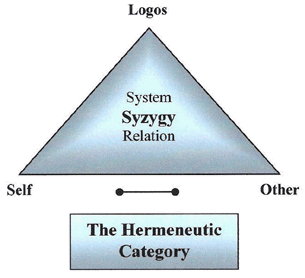
 All understanding begins with one basic Category, the Hermeneutic Category, which is here assumed to be a Syzygy. A Syzygy, as we know, entails two ideas: Duality and Polarity. A Duality, naturally enough, is simply a pair of opposites (such as Yes/No), whereas a Polarity adds a third component to the pair, a new element that conspires to unite the dualistic opposites. That is, in a Polarity the dual opposites are mediated by a "polar" element lying between the opposites, thus serving to mediate between the two extremes of the Duality. In the general form of the Syzygy displayed here, the Duality is the opposition of Self and Other. For the Polarity, the third element—the Logos, seen at the apex of the triangle—unites the opposites displayed at the two ends of the base. All understanding begins with one basic Category, the Hermeneutic Category, which is here assumed to be a Syzygy. A Syzygy, as we know, entails two ideas: Duality and Polarity. A Duality, naturally enough, is simply a pair of opposites (such as Yes/No), whereas a Polarity adds a third component to the pair, a new element that conspires to unite the dualistic opposites. That is, in a Polarity the dual opposites are mediated by a "polar" element lying between the opposites, thus serving to mediate between the two extremes of the Duality. In the general form of the Syzygy displayed here, the Duality is the opposition of Self and Other. For the Polarity, the third element—the Logos, seen at the apex of the triangle—unites the opposites displayed at the two ends of the base.
 Admittedly, not all Dualities are Polarities, for some opposites exist without a third between them; our categorial Syzygy, however—which is represented here as both a triangle (with three corners) or as a pair of dots (the Duality) connected by a line (the Pole)—constitutes a true Polarity. This Syzygy thus entails both of two general forms of Relation—the dyadic and the triadic forms—as well as the simplest form of what we now call a System. A System is defined, roughly, as "many elements working together", and in the Syzygy the Logos serves the specific purpose of uniting the Opposites. The Logos thus represents the linkage between any two things that are somehow related. In many cases, the Logos is just the relationship itself, but that is only because the relationship is not always physically distinct from the two things that are related. This is precisely the situation in the syzygy of marriage, in which two people are united by means of a civil agreement. Admittedly, not all Dualities are Polarities, for some opposites exist without a third between them; our categorial Syzygy, however—which is represented here as both a triangle (with three corners) or as a pair of dots (the Duality) connected by a line (the Pole)—constitutes a true Polarity. This Syzygy thus entails both of two general forms of Relation—the dyadic and the triadic forms—as well as the simplest form of what we now call a System. A System is defined, roughly, as "many elements working together", and in the Syzygy the Logos serves the specific purpose of uniting the Opposites. The Logos thus represents the linkage between any two things that are somehow related. In many cases, the Logos is just the relationship itself, but that is only because the relationship is not always physically distinct from the two things that are related. This is precisely the situation in the syzygy of marriage, in which two people are united by means of a civil agreement.
|

